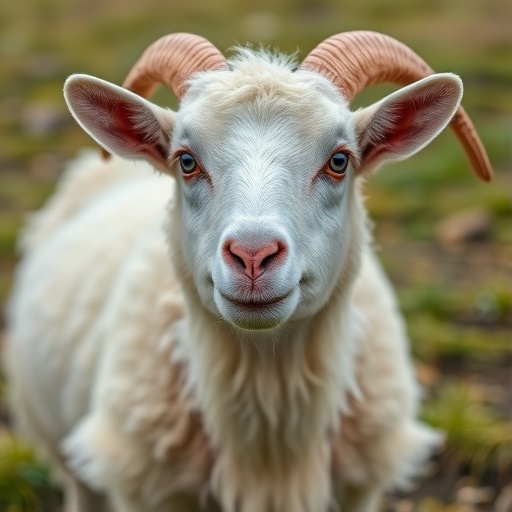Recent advancements in the field of genetics and molecular biology have paved the way for a deeper understanding of the biological processes that govern hair follicle growth. In a compelling new study published in BMC Genomics, researchers have turned their attention to melatonin, a hormone best known for its role in regulating sleep patterns. This innovative research led by a team including L. Xie, C. Li, and J. Tian, delves into the mechanisms behind melatonin’s influence on hair follicle dynamics in cashmere goats. Through an exhaustive integration of transcriptomic and proteomic analyses, the study aims to elucidate the intricate molecular pathways activated by this hormone, promising to ignite further exploration of its potential applications in livestock management and breeding.
Melatonin is synthesized from the amino acid tryptophan, with its production typically peaking during the night. Its multifaceted role in regulating circadian rhythms and modulating various biological processes has sparked interest beyond its traditional bounds. The study’s authors propose that melatonin may also play a critical role in promoting hair growth, particularly in cashmere goats, which are renowned for their luxurious coats. By understanding how melatonin influences hair follicle development, breeders can potentially enhance cashmere yield and quality, a significant economic advantage for regions reliant on goat farming.
The research employed a rigorous methodology that integrated both transcriptomic and proteomic analyses. Transcriptomics, which involves the study of RNA molecules that mediate gene expression, allows researchers to identify which genes are actively being transcribed in the hair follicles of the goats. On the other hand, proteomics focuses on the protein molecules resulting from these genes, providing insights into the actual biological functions at play. This dual approach enables a comprehensive overview of the molecular landscape characterizing hair follicle growth under the influence of melatonin.
One of the most significant findings of the study is the identification of specific gene expression patterns associated with melatonin administration. The authors reported increased expression levels of genes linked to hair follicle growth and development. This correlation suggests a robust mechanism whereby melatonin acts to stimulate the proliferation and differentiation of keratinocytes, the primary cell type found in hair follicles. By promoting these cellular processes, melatonin could enhance the overall growth cycle, leading to increased hair density and length.
Moreover, the study revealed that melatonin modulates the expression of various signaling pathways crucial for hair follicle biology. Pathways associated with cellular metabolism, growth factors, and anti-apoptotic signals were notably affected by melatonin treatment. This activation likely contributes to a favorable microenvironment within the hair follicles, fostering conditions conducive to hair growth. The authors argue that these signaling pathways could represent potential therapeutic targets for improving hair quality and density not only in goats but potentially in other livestock and even in human applications.
In addition to exploring gene and protein expression, the researchers also investigated the comparative aspects of melatonin’s effects across different breeds of goats. The study suggests that there may be inherent genetic differences that influence how various breeds respond to melatonin. This understanding could lead to breed-specific strategies for enhancing hair production, taking advantage of the unique genetic makeup of each breed. Such tailored approaches could optimize production techniques in the cashmere and fiber industries, benefiting farmers and consumers alike.
The implications of these findings extend beyond the agricultural sector, as they could inspire novel applications in the cosmetic industry. Given the increasing consumer demand for effective hair growth products, the insight gained from this research may facilitate the development of new formulations based on melatonin. The potential for leveraging melatonin’s hormonal effects on hair growth opens exciting avenues for research and product innovation, aligning with the trend toward natural ingredients in beauty and personal care.
Furthermore, the research raises intriguing questions about the role of environmental factors in modulating melatonin levels and their consequent impact on hair follicle dynamics. Factors such as light exposure, stress, and nutritional input all influence melatonin synthesis. Thus, understanding how these variables affect melatonin levels might provide additional strategies for managers aiming to optimize hair production in goats throughout various seasons and conditions.
As the scientific community continues to investigate the complexities of hair follicle biology, this study serves as an important milestone, contributing to the growing body of literature connecting hormonal regulation and hair growth. Melatonin’s multifaceted roles in biological systems underscore the importance of exploring hormones not only in clinical settings but also in agricultural practices. The economic implications for improved cashmere production could resonate deeply within affected communities, supporting robust livelihoods and bolstering the sustainability of goat farming.
In conclusion, the integrated transcriptomic and proteomic analysis conducted by Xie, Li, and Tian offers a pioneering perspective on the molecular mechanisms governing melatonin-regulated hair follicle growth in cashmere goats. By shedding light on the specific genes and protein pathways influenced by melatonin, the study propels forward our understanding of hair follicle regeneration. As research in this area evolves, the potential applications expand, establishing a foundation for future innovations in both agriculture and biotechnology that can address pressing economic and consumer demands.
Subject of Research: Melatonin’s role in hair follicle growth regulation in cashmere goats.
Article Title: Integrated transcriptomic and proteomic analysis reveals molecular mechanisms of melatonin-regulated hair follicle growth in cashmere goats and comparative insights across goat breeds.
Article References:
Xie, L., Li, C., Tian , J. et al. Integrated transcriptomic and proteomic analysis reveals molecular mechanisms of melatonin-regulated hair follicle growth in cashmere goats and comparative insights across goat breeds.
BMC Genomics (2025). https://doi.org/10.1186/s12864-025-12263-9
Image Credits: AI Generated
DOI:
Keywords: Melatonin, hair follicle growth, cashmere goats, transcriptomic analysis, proteomic analysis, gene expression, signaling pathways, agricultural biotechnology, livestock management, hair growth products.




